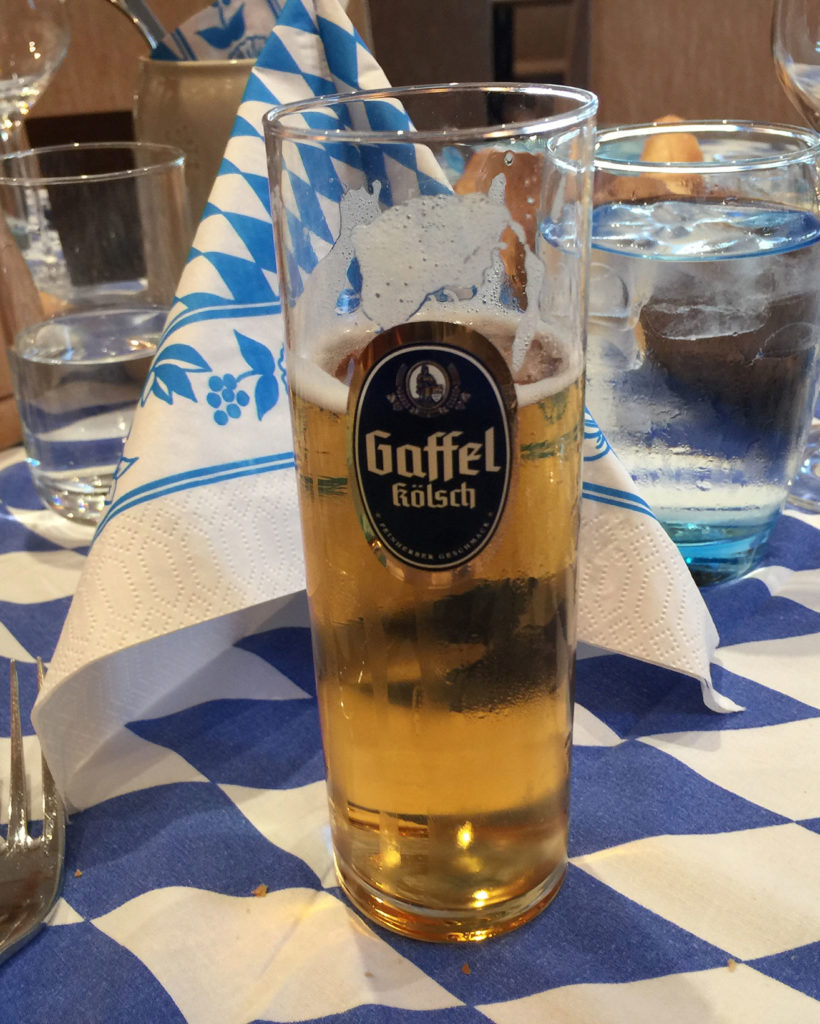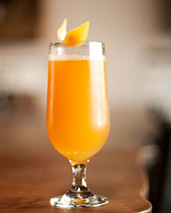Kölsch

Bready
Crisp
Esters
Herbal
Straw
Gold
Amber
Dark Amber
Brown
Black
Straw
Black
Straw to Gold / 3.5 – 5 SRM
Very Low
Low
Moderate
Pronounced
Assertive
Highly Assertive
Very Low
Highly Assertive
Pronounced / 18 – 30 IBU
0%
3%
6%
9%
12%
15%
0%
3%
6%
9%
12%
15%
ABV 4.4 – 5.2% (OG 1.044 – 1.050 with FG 1.007 – 1.011)
Low (Dry)
Medium
High
Low (Dry)
Medium
High
Sweetness Low
Malty
Balanced
Hoppy
Malty
Balanced
Hoppy
Well Balanced between Malt & Hops
HISTORY
If you’ve ever opened a bottle of Bordeaux, Champagne, or Vouvray or poured a dram of Scotch you’ve experienced something we don’t often talk about in the craft beer world: appellations. Appellations exist in many different formats and industries, and they are essentially rules defining a product. They limit various aspects of the products they define including ingredients, process, and the amount that can be produced, but what almost all of them have in common is a geographic region where they can be made. Kölsch–named after Cologne, the Rhine Valley German city it comes from–is one of the very few appellations we have in the beer world (see Trappist Ales for another), and the motivation for its existence is rooted deeply in the history of Cologne and a desire for the best quality beer.
Cologne was the site for some of the very first labor organizations in Medieval Europe. From the early 1100s through the late 1300s, various groups of tradesmen began organizing into guilds to gain political and economic power. This may have been in part a response to the laws and taxes of the time, which encouraged brewers to make weaker beer because they were taxed based on the amount of malt they used. Beer quality suffered (anybody want a 1% ABV beer made with birch bark, dead leaves, and soil?…good because we won’t be pouring any of that) and by the beginning of the sixteenth century several laws began defining purity standards for beer. The iconic 1516 reinheitsgebot or “beer purity law” of Bavaria is the most famous example, but Cologne had its own law in 1495 banning gruit (a precursor beer that was bittered with herbs).
Fast forward several centuries–and several devastating wars and foreign takeovers–and Cologne’s brewers gradually merged into a single brewing lane during the middle decades of the last century. What emerged was a light-bodied, crisp, and dangerously crushable beer brewed with ale yeast but lagered like most of the beer brewed elsewhere in Germany. In 1986, 24 breweries within a 50K radius of Cologne Cathedral formed another guild of sorts, signing the Kölsch Konvention that continues to define what Kölsch is, who can make it, and even how it should be served: in a 200ml (6.5-ounce) thin glass called a Stange (we asked…and no it doesn’t come with a sippy cup lid) that must have the word “Kölsch” on it.
Cologne bartenders place 12-24 empty Stange glasses in a round serving tray called a “Kranze” (or wreath) and rotate / fill all glasses from a tapped 30 liter keg. Wait staff won’t ask if you want another. They will replace any empty Stange with a full one unless you place a coaster over the top of your Stange.
This is one of those beers that thrives on elegant simplicity. Ironically, this makes it one of the most difficult styles to brew because one small change in ingredients or process and you’ve missed the bull’s eye. It’s hard to imagine Kölsch’s powerful appeal unless you’ve been to Cologne and drank a few (dozen) stanges full, but pull up to the bar and try ours…we think it’s a damn close second.
CLASSIC CHARACTERISTICS:
Aroma – Very light malt character with cracker and grain notes. Little to no hop aroma, spicy or herbal if present. Very light fruit (apple, pear) or wine character.
Appearance – Straw to Light Gold and clear with a pillowy head
Flavor – Light, easy-drinking flavor that doesn’t favor malt or hops
Mouthfeel – Crisp, medium-light body with medium carbonation
Vitals – 4.4 – 5.2% ABV, 18 – 30 IBU
Service Notes:
Serve fresh and cold in a Stange at 38°F
BJCP DESIGNATION: 5B, Kölsch
Overall Impression:
A clean, crisp, delicately-balanced beer usually with a very subtle fruit and hop character. Subdued maltiness throughout leads into a pleasantly well-attenuated and refreshing finish. Freshness makes a huge difference with this beer, as the delicate character can fade quickly with age. Brilliant clarity is characteristic.
Aroma:
Low to very low malt aroma, with a grainy-sweet character. A pleasant, subtle fruit aroma from fermentation (apple, cherry or pear) is acceptable, but not always present. A low floral, spicy or herbal hop aroma is optional but not out of style. Some yeast strains may give a slight winy or sulfury character (this characteristic is also optional, but not a fault). Overall, the intensity of aromatics is fairly subtle but generally balanced, clean, and fresh.
Appearance:
Very pale gold to light gold. Very clear (authentic commercial versions are filtered to a brilliant clarity). Has a delicate white head that may not persist.
Flavor:
Soft, rounded palate comprised of a delicate flavor balance between soft yet attenuated malt, an almost imperceptible fruity sweetness from fermentation, and a medium-low to medium bitterness with a delicate dryness and slight crispness in the finish (but no harsh aftertaste). The malt tends to be grainy-sweet, possibly with a very light bready or honey quality. The hop flavor is variable, and can range from low to moderately-high; most are medium-low to medium intensity and have a floral, spicy, or herbal character. May have a malty-sweet impression at the start, but this is not required. No noticeable residual sweetness. May have a slightly winy, minerally, or sulfury accent that accentuates the dryness and flavor balance. A slight wheat taste is rare but not a fault. Otherwise, very clean.
Mouthfeel:
Medium-light to medium body (most are medium-light). Medium to medium-high carbonation. Smooth and generally crisp and well-attenuated.
Comments:
Characterized in Germany as a top-fermented, lagered beer. Each Köln brewery produces a beer of different character, and each interprets the Kölsch Konvention slightly differently. Allow for a range of variation within the style when judging. Note that drier versions may seem hoppier or more bitter than the IBU specifications might suggest. Due to its delicate flavor profile, Kölsch tends to have a relatively short shelf-life; older examples and imports can easily show some oxidation defects. Served in Köln in a tall, narrow 200ml glass called a Stange.
History:
Cologne, Germany (Köln) has a top-fermenting brewing tradition since the Middle Ages, but developed the beer now known as Kölsch in the late 1800s to combat encroaching bottom-fermented pale lagers. Kölsch is an appellation protected by the Kölsch Konvention (1986), and is restricted to the 20 or so breweries in and around Köln. The Konvention simply defines the beer as a “light, highly attenuated, hop-accentuated, clear, top-fermenting Vollbier.”
Characteristic Ingredients:
Traditional German hops (Hallertau, Tettnang, Spalt or Hersbrucker). German Pils or pale malt. Attenuative, clean ale yeast. Up to 20% wheat malt may be used, but this is quite rare in authentic versions. Current commercial practice is to ferment warm, cold condition for a short period of time, and serve young.
Style Comparison:
To the untrained taster, easily mistaken for a cream ale or somewhat subtle Pils.
Vital Statistics:
OG: 1.044 – 1.050
FG: 1.007 – 1.011
ABV: 4.4 – 5.2%
IBUs: 18 – 30
SRM: 3.5 – 5
Commercial Examples:
Früh Kölsch, Gaffel Kölsch, Mühlen Kölsch, Reissdorf Kölsch, Sion Kölsch, Sünner Kölsch
BA DESIGNATION: German-Style Koelsch
- Color: Straw to gold
- Clarity: Chill haze should not be present
- Perceived Malt Aroma & Flavor: Malt character is very low to low with soft sweetness. Caramel character should not be present.
- Perceived Hop Aroma & Flavor: Low, and if present, should express noble hop character.
- Perceived Bitterness: Medium to medium-high
- Fermentation Characteristics: Fruity esters are absent to low, expressed as pear, apple or wine-like attributes when present. Diacetyl should not be present.
- Body: Low to medium-low. Dry and crisp.
- Additional Notes: Traditional examples often display persistent head retention. Small amounts of wheat can be used in brewing beers of this style. Koelsch-style beers are fermented at warmer temperatures than is typical for lagers, but at lower temperatures than most English and Belgian-style ales. They are aged cold. Ale yeast is used for fermentation. Lager yeast is sometimes used for bottle conditioning or final cold conditioning.
Original Gravity (°Plato) 1.042-1.048 (10.5-11.9 °Plato)
Apparent Extract/Final Gravity (°Plato) 1.006-1.010 (1.5-2.6 °Plato)
Alcohol by Weight (Volume) 3.8%-4.2%(4.8%-5.3%)
Bitterness (IBU) 22-30
Color SRM (EBC) 3-6 (6-12 EBC)
STYLE COMPARISON:
Very similar to cream ale, but without corny sweetness. Can also taste like a German Pilsner with much less hop character and bitterness.
INGREDIENTS:
- Continental pilsner malt
- Malted wheat
- German noble hops
BREWING PROCESS:
Many of Cologne’s brewers use a step mash that brings the malted grain through several temperatures in order to get the best starch conversion for a clean, dry finish. Some brewers suggest using a very thin mash to avoid over-sparging and extracting harsh tannins that affect drinkability.
SUGGESTED FOOD PAIRINGS:
AT THE BREWPUB: Embered Endive Salad
TAKEOUT: Lobster Rolls or Fish Tacos (light on the spice)
CASUAL DATE: Just about anything on the menu
SUGGESTED SPIRIT PAIRINGS:
FROM BF DISTILLING CO: ***
ANY: Light Oaked Brandy
SUGGESTED MUSIC TO LISTEN TO:
Can (a Cologne progressive band from the 70’s)
OLD: Haydn string quartets
BEER COCKTAIL RECIPE:

Sommerwind
(Summer Breeze)
INGREDIENTS:
- 6 ounces BF Kölsch-Style Ale
- 2 ounces Gewürstruminer (or other sweet white wine)
- .5 ounce raspberry syrup
- Mint leaves for garnish
DIRECTIONS:
In a stemless wine glass, pour 2 ounces Gewürstruminer into bottom of glass, then fill with BF Kölsch-Style Ale. Drizzle raspberry syrup into glass and garnish with mint leaves.
BLACK FLANNEL BREWING CO. EXAMPLE: Sommer Kölsch
Brewing Notes:
Following Chris Kesler’s trip to the the Rhine Valley of Germany in the summer of 2018, he became obsessed with brewing a Kölsch-style Ale that remained faithful to the true nature of the style. With a few tips he picked up while in Cologne, Chris developed a simple recipe using traditional mash and fermentation techniques. The results speak for themselves. Come in and have a few Stange’s. You’ll get a true sense of the experience you might expect sitting in a Cologne brewpub.
Tasting Notes:
Black Flannel’s Kölsch-style ale is a trip to traditional European beer culture in a glass. Light cracker sweetness from malt, very low spicy hops for balance, slight apple character from the yeast, and a light, dry finish make this a perfect beer to savor simplicity or mow the lawn.